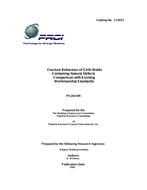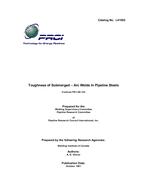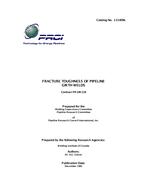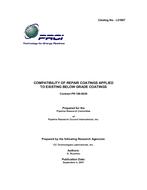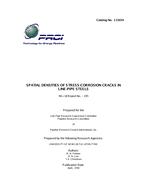Provide PDF Format
PRCI PR-202-009
- Fracture Behavior of Girth Welds Containing Natural Defects, Comparison with Existing Workmanship Standards
- Report / Survey by Pipeline Research Council International, 02/09/1992
- Publisher: PRCI
$448.00$895.00
L51653e
University of Gent-Belgian Welding Institute
Need: The first use of radiographic standards for inspection and acceptance of finished girth welds was adopted by API in 1953. This standard was largely based on the "Unfired Pressure Vessel Code" which was adopted by ASME in 1931. At that time and to this day, weld defect acceptance standards are based on workmanship principles. In other words, the so called "Workmanship defect acceptance standards" reflect the weld quality levels produced by. a trained welder using satisfactory materials, equipment and procedures. For many years exclusive use was made of the API 1104 workmanship defect acceptance levels for all field pipeline and related facilities welds. This, and very similar defect acceptance standards (e.g. BS 4515, CSA 2184, AS 1697, etc.) are used in many countries throughout the world. Though the specified acceptance levels have no scientific basis, the use of workmanship standards has provided an adequate level of quality control for many years. Particularly worthy of attention in this context is the fact that the currently stipulated levels have been developed for welds in lower strength pipe grades. Unfortunately, the developments in acceptance levels have not kept pace with those occurring in-pipeline technology. Furthermore, pipe size, strength and toughness, weld metal properties or pipeline operating conditions are not considered in the present-day defect acceptance standards. Problems of this kind have led companies involved in gas/oil transporting activities to develop their own standard requirements or at least to produce a supplement to the general standards.
Result: This report describes the results of an investigation into the engineering significance of girth weld defect acceptance criteria based upon weld quality (or workmanship) considerations. To this end, research efforts were divided into a theoretical and an experimental part. The theoretical study involved a comparison of internationally used weld quality standards and codes for pipeline welding in order to identify the general features common to them and to obtain a clear view of the different acceptability criteria. The experimental part was designed to provide factual information on the failure behaviour of defective girth welds in large pipe diameter pipe lines. The focal point of the experimental examinations was to compare, on the basis of wide plate test specimen behaviour, the performance levels of girth welds containing planar weld defects which were grossly out of tolerance with respect to most present-day weld quality (workmanship standards) specifications.
Benefit: The results of the study demonstrated that current workmanship code requirements for the acceptance of weld defects/discontinuities merit credit as they are useful in quality control.
University of Gent-Belgian Welding Institute
Need: The first use of radiographic standards for inspection and acceptance of finished girth welds was adopted by API in 1953. This standard was largely based on the "Unfired Pressure Vessel Code" which was adopted by ASME in 1931. At that time and to this day, weld defect acceptance standards are based on workmanship principles. In other words, the so called "Workmanship defect acceptance standards" reflect the weld quality levels produced by. a trained welder using satisfactory materials, equipment and procedures. For many years exclusive use was made of the API 1104 workmanship defect acceptance levels for all field pipeline and related facilities welds. This, and very similar defect acceptance standards (e.g. BS 4515, CSA 2184, AS 1697, etc.) are used in many countries throughout the world. Though the specified acceptance levels have no scientific basis, the use of workmanship standards has provided an adequate level of quality control for many years. Particularly worthy of attention in this context is the fact that the currently stipulated levels have been developed for welds in lower strength pipe grades. Unfortunately, the developments in acceptance levels have not kept pace with those occurring in-pipeline technology. Furthermore, pipe size, strength and toughness, weld metal properties or pipeline operating conditions are not considered in the present-day defect acceptance standards. Problems of this kind have led companies involved in gas/oil transporting activities to develop their own standard requirements or at least to produce a supplement to the general standards.
Result: This report describes the results of an investigation into the engineering significance of girth weld defect acceptance criteria based upon weld quality (or workmanship) considerations. To this end, research efforts were divided into a theoretical and an experimental part. The theoretical study involved a comparison of internationally used weld quality standards and codes for pipeline welding in order to identify the general features common to them and to obtain a clear view of the different acceptability criteria. The experimental part was designed to provide factual information on the failure behaviour of defective girth welds in large pipe diameter pipe lines. The focal point of the experimental examinations was to compare, on the basis of wide plate test specimen behaviour, the performance levels of girth welds containing planar weld defects which were grossly out of tolerance with respect to most present-day weld quality (workmanship standards) specifications.
Benefit: The results of the study demonstrated that current workmanship code requirements for the acceptance of weld defects/discontinuities merit credit as they are useful in quality control.
Related Products
PRCI PR-186-0029
Compatibility of Repair Coatings to Existing Below Grade Coatings..
$298.00 $595.00

